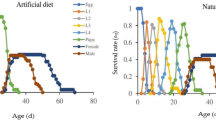Abstract
LOCUSTS are being increasingly used for research and teaching purposes, but one of the main difficulties involved in maintaining a culture is the provision of an adequate supply of fresh green grass throughout the year1. A further disadvantage of this grass diet was revealed by biochemical investigations into the variation with age of the concentration of reducing substances in the hæmolymph of Schistocerca gregaria Forsk., to be reported elsewhere. The above pattern of variation was partially masked by the considerable divergence of many results from the mean values. In view of these divergences, which were thought to be due to differences in the quality of the grass diet, an artificial diet was formulated. The use of this diet, to which very small quantities of fresh green grass were added, considerably reduced these divergencies.
This is a preview of subscription content, access via your institution
Access options
Subscribe to this journal
Receive 51 print issues and online access
$199.00 per year
only $3.90 per issue
Buy this article
- Purchase on Springer Link
- Instant access to full article PDF
Prices may be subject to local taxes which are calculated during checkout
Similar content being viewed by others
References
Hunter-Jones, P., “Instructions for Rearing and Breeding Locusts in the Laboratory” (Anti-Locust Research Centre, London, 1956).
Author information
Authors and Affiliations
Rights and permissions
About this article
Cite this article
HOWDEN, G., HUNTER-JONES, P. An Artificial Diet for the Laboratory Rearing of Locusts. Nature 182, 1527–1528 (1958). https://doi.org/10.1038/1821527a0
Issue Date:
DOI: https://doi.org/10.1038/1821527a0
Comments
By submitting a comment you agree to abide by our Terms and Community Guidelines. If you find something abusive or that does not comply with our terms or guidelines please flag it as inappropriate.



